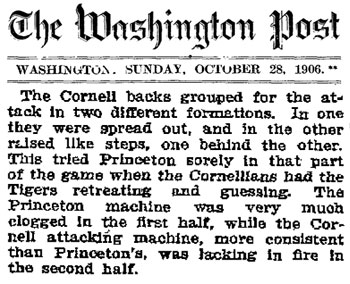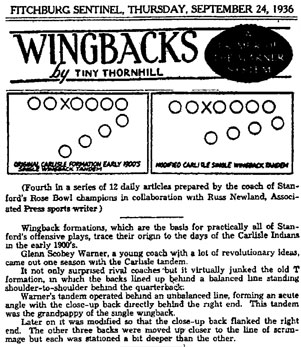Single Wing Turns 100 in 2006
February 20th, 2006
The following message was sent to Coach Grant Teaff, president of the American Football Coaches’ Association (AFCA) November 8, 2005:
Coach Teaff: Please see the attached article from the Washington Post of October 28, 1906, and the piece by Coach Claude “Tiny” Thornhill of Stanford from the Fitchburg Sentinel in 1935.
The 1906 description of the Princeton Tigers versus the Cornell Indians, coached by Glenn Scobey “Pop” Warner, states the following:
“The Cornell backs grouped for the attack in two different formations. In one they were spread out, and in the other raised like steps, one behind the other.”

If you will now turn to the article by Coach Thornhill, who played for Warner at Pitt in 1915, you will see two diagrams, one of the “Original Carlisle Formation Early 1900’s; Single Wingback Tandem,” and the other of the “Modified Carlisle Single Wingback Tandem.”

As Thornhill states about the earlier version of the formation, “Warner’s tandem operated behind an unbalanced line, forming an acute angle with the close-up back directly behind the right end.”
He then adds: “Later on it was modified so that the close-up back flanked the right end. The other three backs were moved up closer to the line of scrimmage but each was stationed a bit deeper than the other.”
I believe the description given by the reporter covering the 1906 Cornell-Princeton game of the formation “raised like steps” is identical with the “Single Wingback Tandem” which Coach Thornhill dates to “the early 1900’s at Carlisle.” Coach Warner was at Cornell through the 1906 season, then moved to Carlisle to coach at the Indian Industrial School starting in 1907.
I believe, therefore, that the Post article pinpoints the 1906 season as the first where Pop Warner deployed the Single Wingback Tandem formation in a game. The Post article also comments about the effects the rules changes for 1906 had on the play of the game, with “the ball…exposed to the stands by the open play.” I see this as further evidence that the Cornell Single Wingback Tandem was something new and different for 1906.
I hope this will suffice as evidence that the Single Wing offense turns 100 in 2006. The above research was conducted by Russell Farley, proprietor of the Football Booklist website, and a student of the game of high repute for many years now.
The aftermath is that Single Wing Historian Ed Racely attended the AFCA convention in January, where no mention was made of the 100th anniversary of the single wing…so who has a good idea for an appropriate commemoration? The NCAA itself is celebrating its centennial in 2006, for exactly the same reasons the single wing is.
It’s the Spin That Wins!
Ted Seay
seayee at hotmail dot com
The Games Do Count
February 6th, 2006
From: The Games Do Count — America’s Best and Brightest on the Power of Sports
Author: Brian Kilmeade, 2004
Gerald Ford
Former President of the United States
Football

When I was ten or eleven years old, I starred playing sports in a local playground in Grand Rapids, I liked the competition, even as a beginner. Somehow, it stimulated me and excited my interests.
Football was my principal sport in high school. I was captain of the team and all-state. I remember the hours I spent learning to center the ball for speed and accuracy. The center was forced to view everything upside down. The opposing lineman had the jump on you and to carry out your blocking assignment you had to be very quick. You also had to perfect different types of snaps.
My playing football and getting my name in the papers led to my biological father finding me. He surprised me one day when I was working in a hamburger stand. My job was to slap hamburgers on the grill, handle the cash register, and wash dishes. One day, at noon, I was behind the counter in my regular spot near the register when I noticed a man standing by the candy display a case. He’d been there fifteen or twenty minutes without saying a word and he was staring at me. “I’m Leslie King, your father,” he said. “Can I take you to lunch?”
I was stunned and didn’t know what to say. I stared at him a minute and then finally said, “I’m working.”
“Ask your boss if you can get off,” he said.
My father took me outside to a new Lincoln. A woman was sitting inside. He introduced her as his wife. They’d taken the train to Detroit from Wyoming, where they lived, had purchased the car, and now they were driving home through Grand Rapids. He asked me about sports and wanted to know all about my playing football at Sough High. We didn’t mention the divorce or anything else disagreeable. After lunch, he drove me to school and handed me $25. “Now, buy yourself something — something you want that you can’t afford otherwise.” That night was one of the most difficult of my life. I don’t recall the words I used to tell my parents what had happened, but I remember that the conversation was a loving and consoling one.
My parents didn’t really have enough money to send me to college, but I got a scholarship to the University of Michigan and I earned some money working at part-time jobs. I played on the freshman team and won the Meyer Morton Trophy, which was a silver football, as the outstanding freshman player at spring practice. That first year, I spent a lot of time on the bench, because we had Chuck Bernard, who was an All-American. But during my sophomore and junior years, we were undefeated and national champions. We used the “punt, pass, and prayer” style of playing. The theory was that if you had a good punter, a good passer, and a strong defense, you would always win.If you won the coin toss, you always kicked off and gave the other team the ball. You counted on your defense to force them into mistakes. Inside your own 40-yard line, you always punted on second or third down. if you were near your own goal line, you punted on first down. If your punter did his job, you could pick up 10 or 15 yards on every exchange. Then, if your quarterback connected on his passes, you could score and score again.
Our team fell apart my senior year, because we lost most of our starters to graduation and our quarterback, Bill Renner, broke his leg before the first game of the season and was out the whole year. Our most heartbreaking defeat came against Illinois. It was a horrible, rainy day, and the ball was so slippery it was tough to handle. We must have punted 15 or 20 times. Despite the slippery ball, I had a perfect day, but we lost 7-6.
“As a football player, you have critics in the stands and critics in the press.”
There’s no question that my experience and exposure to athletics had a major impact on my future. In fact, I think that sports, particularly football, gave me an opportunity to be out front, to be a leader, which helped me later on, when I got into politics.
I think my dealings with the press had as much of an impact on my later life and the success I had as actually playing in Michigan Stadium. As a football player, you have critics in the stands and critics in the press. Few of them ever centered a ball, kicked a punt, or thrown a touchdown pass with 100,000 people looking on, yet they assume they know all the answers. Their comments helped me develop a thick hide, and in later years, whenever critics assailed me, I just let their jibes roll off my back.
Direct Snap Note: Thanks to Deron Bayer for this contribution.